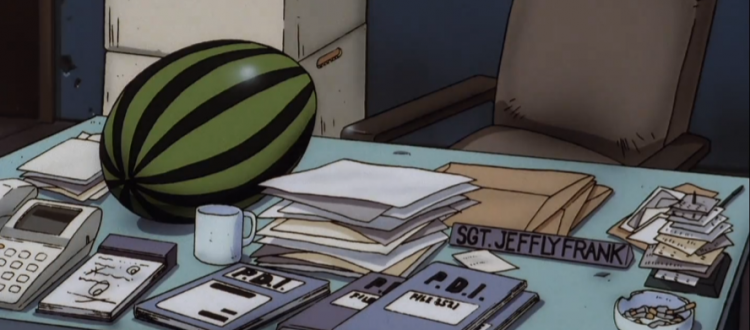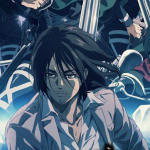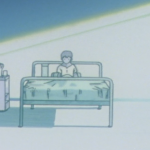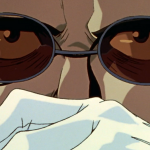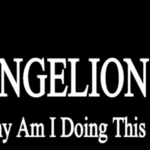Adios, Cowboy: Review 17 – Mushroom Samba
Okay, Cowboy Bebop. I want you to know that I tried. I really tried to see in you what everybody else seems to see. I approached you with humility, with hope. I saw in you the fodder of a thousand gleaming think pieces, and this is how you have repaid me. I need you to understand that you brought this on yourself.
Hey, Critic Adam, you’re in.
Hey kids, it’s me, your old buddy Critic Adam. Student Adam is off feeling betrayed and wondering what is wrong with people. That leaves me large and in charge to give Cowboy Bebop the full nine yards. And let me tell you, this episode deserves every goddamn bullet I am going throw at it.
Let’s start with the utterly contrived nonsense that moves this episode’s pathetically thin story from start to a little further down the road from start, just astride your racist old uncle’s house. The Bebop crew, our super hip, always smoking, always cool protagonists are so utterly bad at their jobs that they’ve not only run out of food, they’ve run out of gas…in space. When they crash land on Io, which is somehow a nicer place in this setting than Callisto, their only, and I mean only, contribution to the story is to trip balls on magic mushrooms. That’s it. They are zero-sums to this story that lets Ed and Ein muck about amid a creepy and probably bad take on Blaxploitation films.
That’s right, I’m throwing out the race card. Student Adam was trying to see the good in life back when he said that Abdul Hakim was an unapologetically black character in Stray Dog Strut. He wanted to hope that the bandito bounty hunters, who were a stone’s throw from proclaiming they didn’t need no stinking badges, in Heavy Metal Queen were a deconstruction of the trope rather than the show rolling around in other people’s stereotypes like a sow in stink. But there’s no way to handwave away the shitty things that Mushroom Samba does, and that’s why I’m here.
I’m here to see the things you don’t want to see while you’re praising the show for its existentialism and critique on capitalism. It’s not really a critique, it’s observation that feels smarter than it is because the world we live in has made every damn thing political. I am here to ruin your childhood.
So Ed and Ein are walking down a desert road on Io when Foxy Brown (N.B. not actually this character’s name. Her name is never said during the episode, and there’s no way this character isn’t Pam Grier) shows up, wearing nothing but a cleavage enhancing trench coat. She then buys a watermelon.
I’ll give you a moment to read that twice. Because you might be thinking that I’m making things up. Or you might be thinking I’m setting up for a straw man and getting my nose out of joint over the juxtaposition of a single black character and a watermelon for no reason.
After the PDI (that’s police department of Io) search Foxy’s car for no reason while she is getting gas, a scene that also includes the cops keeping the watermelon in frame with Foxy, Ed and Ein come upon a black guy called Domino who is…wait for it…a drug pusher. Ed and Ein only bother interacting with him because he’s stuffing his face with a hotdog, which Ed believes he should have shared. While Ed and Ein are chewing at Domino’s ankles, a man called Shaft – I shit you not, his name is Shaft – shows up with a coffin in tow and demands vengeance against Domino for selling some bad magic mushrooms to his older brother.
All of these things are happening in this episode.
The only thing missing from Shaft’s character design is a fedora with a big ass feather to compliment his ankle-length purple double-breasted trench coat.
Cut back to: Foxy getting interrogated by the cops and she is constantly in frame with her watermelon. It’s not enough that every woman in this show be reduced to legs and cleavage. Now we’re using the watermelon as a way to block the scene and reinforce identity? What sort of bullshit is this? Why is it necessary? I’ll give you I might be reading too much into things, but I dare you to give me an interpretation of this tableau that isn’t gormless and lazy.
Even though this show is set in the 2070s, there’s not a lot going on beyond the portrayal of black people that says the solar system is enraptured with the 1970s’ popular culture. This is a show steeped in jazz not disco. Even then, there are literary references to Herman Melville in this specific episode, so there’s no arguing “that’s the culture, Adam,” as if a particular cinematic subgenere from the 1970s, writ large, is this show’s aesthetic. I mean you can argue it, and then I will slowly nod and make a wanking gesture, building speed as you continue to spew your shitty hot takes.
No, this is has to be where a line is drawn. Cowboy Bebop was released in 1998, and even Teenage Adam in 1998 knew that this kind of depiction of people of colour was dubious. He might not have known all the historical context, but he knew enough to turn his head sideways and squint. So don’t come at me with the historical context argument, either. This is the kind of reducto ad racist stuff that the target demographic in the 90s had the decency to feel embarrassed about when their respective fathers started sounding off about it at family dinners.
Cut to: Ed and Ein running down Domino on to the top of a train; therein, Shaft gets involved in the chase. How does this happen, you ask? Of course by coming full circle to the start of the episode. Shaft carjacks the watermelon truck where Foxy Brown bought her watermelon. The magic contrivances of plot that drive Cowboy Bebop would abide nothing else but a truck full of watermelons as three black characters are sharing a scene.
Somehow Keiko Nobumoto and Shinichirō Watanabe managed to take the most surface level reading of Blaxsploitation films and junk everything about them that understood empowerment and re-appropriation as cornerstones of their ethos. It is as if they watched Shaft but decided to skip over all of the context. Civil rights, race relations, systemic racism, what are those things? We’ve certainly never heard of them on Io or within the Bebop solar system.
Student Adam said it best back in his review of Ballad of the Fallen Angel: doing something once might be an accident, but cutting back to it over and over shows intention. From where I am sitting, and from the corner where Student Adam is off whimpering and demanding to know what his friends ever saw in this show, Cowboy Bebop is playing shitty racism for laughs in an episode that mobilizes the series’ most adorable characters as a shield against criticism or constructive feedback.
But Adam, someone whines from the cheap seats, Space Doggo.
Yeah. I remember that argument. I’m not buying it today. There’s no flashing a corgi and the show’s gender-unexpected darling as a balm for intentionally, not thoughtlessly, but intentionally framing the people of colour in the show as either sexpots, drug pushers, or gangsters.
So now comes the big question: who writes the next nine reviews, me, awesome Critic Adam, or that sad Student Adam waiting for some senpai to notice him. Get over it, pal. You have no senpai. I’m all you have.
Student Adam came here to learn because people he respected said things like, “Cowboy Bebop taught me how to write good science fiction.” I’m here because the lessons on what not to do are getting a bit much. Both Adams want to drive into the rich world building, but now we are both thinking that this show might be more flash than substance. Maybe the motifs and themes are little more than sophomoric attempts at scoring cleverness points.
Okay, you can stop crying now, Student Adam. I said all of the things about the episode. Maybe the next one will be better, but for now hanging around in case you need me again.

